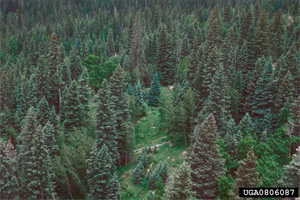|
The term disturbance will be used here to represent any discrete event in time that disrupts ecosystem composition, structure or function (Barnes et al. 1998).
Due to the nature of the disturbance process we often associate it with death and destruction; however we must consider the idea that disturbances are in fact natural events in all ecosystems.

Dave Powell, USDA Forest Service, www.forestryimages.org
When discussing disturbances we must consider the concept of scale.
At large scales such as the western U.S. macroclimate and physiography will strongly affect the kinds of disturbances found.
As we move from a macro scale to a local scale we must consider specific ecosystem characteristics as well as the relationship of one ecosystem to other ecosystems.
These factors will help us determine the kind of disturbances that an ecosystem may encounter as well as their frequency and severity.
As we have mentioned disturbances not only effect individual plants and communities but have effects on the physical site as well (Barnes et al. 1998).
Disturbances such as glaciation and volcanism have major influences on site development by creating new landforms and rearranging parent material especially at large scales.
On smaller scales wind and fire can change the physical site as well.
The point to this is that not only do disturbances have direct effects on plants and plant communities but they also have many indirect effects.
|
